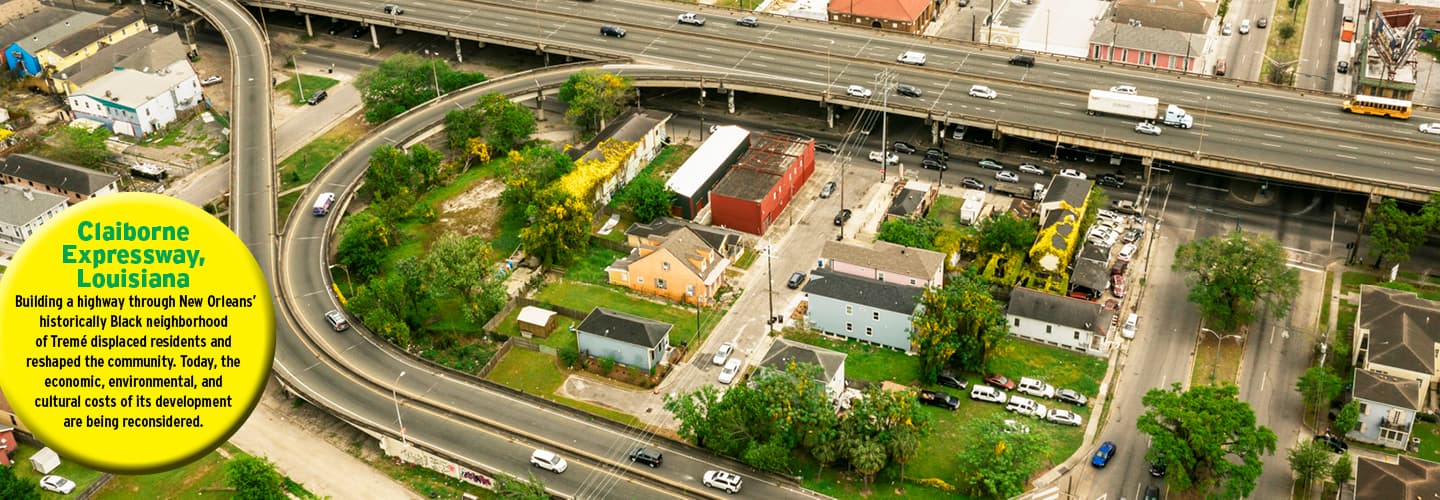North Claiborne Avenue in Tremé—a historically Black neighborhood in New Orleans, Louisiana—once buzzed with cafes, local businesses, and social clubs that brought the community together on the bustling pedestrian-friendly street.
“It was like the Harlem Renaissance,” says Raynard Sanders, executive director of the Claiborne Avenue History Project. “There was this emergence of Black writers, poets, and all kinds of social activists. . . and the genesis of America’s only art form, which is jazz.”
But in 1968, a new elevated stretch of Interstate 10 tore through the heart of the neighborhood. To make way for the federally funded road, known as the Claiborne Expressway, workers bulldozed 500 homes, 80 businesses, and a large row of giant oak trees. The highway displaced residents and cut neighbors off from one another as the roar of vehicles zooming overhead replaced the music that had long streamed from local jazz halls.
“If you talk to anybody in Tremé,” says salon owner Lynette Boutte, whose family’s roots in the neighborhood trace back generations, “they can tell you about the day the trees came down or when the highway was built.”
For decades, people in Tremé have envisioned a day when the highway might be gone—or at least closed off to traffic—and the neighborhood restored to its former vibrancy.
Tremé is one of many urban neighborhoods that suffered or disappeared entirely as highways began springing up across the U.S. in the late 1950s, often cutting through the heart of low-income and minority communities. But Tremé is also one of many places today where people are coming together to try to remove or reimagine those highways.
North Claiborne Avenue in Tremé is a historically Black neighborhood in New Orleans, Louisiana. It once buzzed with cafes, local businesses, and social clubs. These venues brought the community together on the vibrant, walkable street.
“It was like the Harlem Renaissance,” says Raynard Sanders, executive director of the Claiborne Avenue History Project. “There was this emergence of Black writers, poets, and all kinds of social activists . . . and the genesis of America’s only art form, which is jazz.”
But in 1968, a new elevated stretch of Interstate 10 tore through the heart of the neighborhood. The federally funded road was known as the Claiborne Expressway. To make way for it, workers bulldozed 500 homes, 80 businesses, and a large row of giant oak trees. The highway displaced residents and cut neighbors off from one another. And the roar of vehicles zooming overhead replaced the music that had long streamed from local jazz halls.
“If you talk to anybody in Tremé,” says salon owner Lynette Boutte, whose family’s roots in the neighborhood trace back generations, “they can tell you about the day the trees came down or when the highway was built.”
For decades, people in Tremé have dreamed of a day when the highway might be gone or at least closed off to traffic. They want to see the neighborhood restored to its former glory.
Tremé is one of many urban neighborhoods that suffered or disappeared entirely because of the highway building boom. Highways began springing up across the U.S. in the late 1950s. They often cut through the heart of low-income and minority communities. But Tremé is also one of many places today where people are coming together to try to remove or reimagine those highways.

